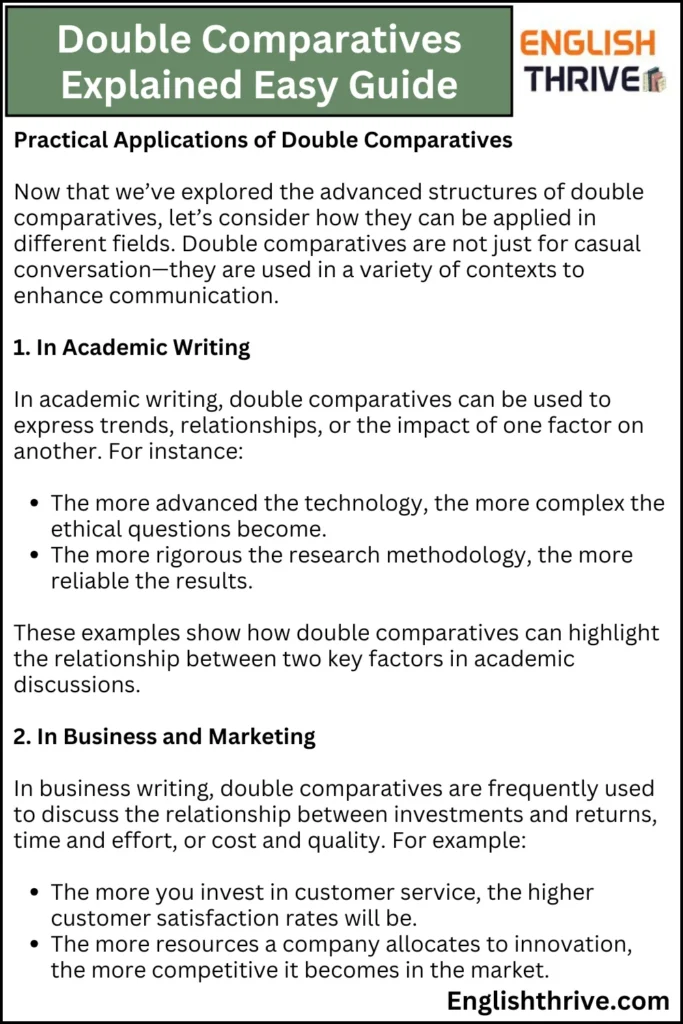When speaking or writing in English, we often use comparisons to express how one thing is different from another. Among the various ways to make comparisons, double comparatives play an important role. These are not just another grammatical structure; they are vital in showing continuous increase or decrease and adding a nuanced layer to our expressions. In this article, we’ll explore what double comparatives are, how to use them effectively, and the common mistakes to avoid.
But first, let’s address the big question: What exactly is a double comparative?
Contents
ToggleWhat Are Double Comparatives?
A double comparative is a grammatical structure used to express a relationship between two things that is either increasing or decreasing. It involves using comparative forms like more, less, or comparative adjectives, repeated twice in one sentence.
In simpler terms, double comparatives are used to show how one thing becomes more or less as a result of another factor.
Examples of Double Comparatives
Here are some classic examples that will help you grasp the idea:
The more you study, the more you learn.
The less time you spend on a task, the worse the results.
The more expensive the product, the better the quality.
In these examples, the structure follows a predictable pattern:
The + comparative adjective/adverb + (noun) + subject + verb + , + the + comparative adjective/adverb + (noun) + subject + verb.
This structure highlights how one action or factor leads to another in a proportional way.
Why Use Double Comparatives?
Double comparatives allow for emphasis. They underscore the relationship between two things in a way that draws the reader’s or listener’s attention. They’re not only useful for making statements but also for expressing cause-and-effect relationships in a more vivid manner. For example, saying “The harder you work, the more successful you become” emphasizes the direct correlation between effort and success.
This style of comparison is also used in everyday language to show ongoing changes or trends. For instance:
“The more I study, the easier it gets.”
“The harder the exam, the more time I need to prepare.”
It helps to break down the link between effort and outcome, action and consequence.
How to Form Double Comparatives
To properly construct double comparatives, follow these easy steps:
Use a comparative adjective or adverb: This can be the form of an adjective or adverb that expresses a higher degree of something.
“higher”, “greater”, “stronger”, “more difficult”, “more expensive”, etc.
Structure the sentence: You can structure the sentence in several ways to make it clear and grammatically correct.
The more + noun + subject + verb, the more + noun + subject + verb.
The more expensive the item is, the more luxury you experience.
Use more or less for adjectives or adverbs: These words can help show the comparative form in relation to size, cost, time, or other measurable factors.
The less effort you put in, the fewer rewards you reap.
Variations in Double Comparatives
Double comparatives can appear in a variety of forms. They don’t always have to follow a simple pattern. Here are some examples of more complex structures:
The more + noun + subject + verb, the + comparative adjective + noun + subject + verb:
The more money he earns, the more he spends.
Reversing the order:
The richer the person is, the more privileges they enjoy.
Using comparative adjectives:
The shorter the distance, the faster we arrive.
These variations allow for greater flexibility in how we express relationships between things.
Double Comparatives to Show Change
Double comparatives are also effective in expressing ongoing changes or trends. This shows a continual increase or decrease over time. Here are a few examples:
“The more people travel by train, the less pollution there is on the road.”
“The less time you spend on distractions, the more productive you’ll be.”
In both examples, the double comparative emphasizes an ongoing, gradual change between the two linked ideas.
Common Mistakes with Double Comparatives
While double comparatives can add flavor and depth to writing, they are often misused. Let’s look at some common mistakes to avoid:
1. Incorrect use of “more” and “-er”
It’s common to see people using both “more” and “-er” in the same adjective, which is incorrect. Here are some wrong examples:
“She is more funnier than Tom.”
“This is more tastier than the other.”
The adjective “funny” should be “funnier,” and “tasty” should be “tastier” without the use of “more.”
Correct:
“She is funnier than Tom.”
“This is tastier than the other.”
2. Unnecessary use of “more” with adjectives ending in “-er”
When an adjective already ends in “-er,” you don’t need to add “more” before it. For example, instead of saying “more taller,” just say “taller.”
Incorrect:
“He is more taller than Frank.”
Correct:
“He is taller than Frank.”
3. Overuse of Double Comparatives
Sometimes, double comparatives are overused, especially in colloquial speech, which can make writing sound repetitive or clunky. Use them only when necessary for emphasis, or to add variety to the sentence structure.
Correct Examples:
“The more you practice, the better you get.” (This emphasizes the process of improvement over time.)
Incorrect Example:
“The more you study, the more you get smarter.” (This becomes redundant because “smarter” already conveys the idea of improvement.)
Advanced Forms of Double Comparatives
While the most common form of a double comparative follows a basic structure, there are several advanced variations that allow you to adjust the tone, complexity, and impact of your statements. Let’s explore some of these structures and how they can be applied effectively.
1. Using Comparative Adjectives with Nouns
One of the more advanced uses of double comparatives involves combining comparative adjectives and nouns. This form emphasizes not just the adjective but also the specific noun being described. It allows for a more nuanced and detailed expression.
Example:
The more powerful the engine, the faster the car can go.
The better the ingredients, the tastier the dish.
In these examples, the adjective (e.g., “powerful” and “better”) is paired with a noun (“engine” and “ingredients”) to convey the effect of one factor on the other.
2. Inverted Structure for Emphasis
Inverting the structure of double comparatives can make your sentences more dramatic and emphasize the relationship. Instead of starting with the “the more” or “the less,” you can flip it to put more focus on the second part of the comparison.
Example:
The more you give, the more you receive.
The more he practices, the better his skills become.
This inverted form adds variety to your writing and is often used in persuasive writing or speeches to make a statement more compelling.
3. Using Double Comparatives for Negative Outcomes
While double comparatives are often used to show positive relationships (e.g., the more you practice, the better you get), they can also be used to highlight negative trends. By using “less” in both parts of the structure, you can convey a diminishing relationship between two factors.
Example:
The less time you dedicate to study, the lower your grades will be.
The less effort you put in, the worse the results become.
This form is effective for cautionary statements or when warning someone about the consequences of their actions.
4. Using Double Comparatives for Proportional Change
In addition to showing a cause-and-effect relationship, double comparatives can also be used to show proportional changes. This form highlights that one factor increases or decreases in direct proportion to another.
Example:
The more you exercise, the more your energy levels improve.
The more you save, the greater your financial security.
This use of double comparatives is especially common in self-help and motivational writing, where it emphasizes the benefits of consistent action.

Practical Applications of Double Comparatives
Now that we’ve explored the advanced structures of double comparatives, let’s consider how they can be applied in different fields. Double comparatives are not just for casual conversation—they are used in a variety of contexts to enhance communication.
1. In Academic Writing
In academic writing, double comparatives can be used to express trends, relationships, or the impact of one factor on another. For instance:
The more advanced the technology, the more complex the ethical questions become.
The more rigorous the research methodology, the more reliable the results.
These examples show how double comparatives can highlight the relationship between two key factors in academic discussions.
2. In Business and Marketing
In business writing, double comparatives are frequently used to discuss the relationship between investments and returns, time and effort, or cost and quality. For example:
The more you invest in customer service, the higher customer satisfaction rates will be.
The more resources a company allocates to innovation, the more competitive it becomes in the market.
These statements emphasize the cause-and-effect relationships crucial in business strategies and marketing tactics.
3. In Casual Conversation
In everyday language, double comparatives are commonly used to express changes in personal situations or general observations. Here are a few examples:
The more you travel, the more you learn about different cultures.
The more you help others, the happier you feel.
These examples reflect how double comparatives can add depth and emphasis to personal experiences.
4. In Literature and Storytelling
Writers often use double comparatives to enhance the imagery and impact of their storytelling. By using this structure, they can draw comparisons that highlight the relationship between characters, actions, and outcomes. For example:
The more she fought against her fears, the stronger she became.
The more the city grew, the more isolated its residents felt.
In literature, double comparatives help convey character development or the progression of a story in a more dynamic way.
Double Comparatives in Common Idioms
Double comparatives are also used in many idiomatic expressions and proverbs, which are phrases that have been passed down through generations. These idioms often serve as life lessons or observations, highlighting the relationship between two things. Here are some common examples:
The more, the merrier – The more people there are, the more enjoyable an event will be.
The sooner, the better – It is better to do something quickly.
The higher the risk, the higher the reward – Risk and reward are often proportional.
These idiomatic phrases can make communication more engaging and memorable.
FAQs On Double Comparatives
What is an example of a double comparative?
A common example of a double comparative is: The more you study, the more you learn. It shows that as one thing increases, another also increases.
What is a double comparative and superlative?
A double comparative compares two things that change together, like the harder you work, the better you get.
A double superlative happens when two superlative forms are used together by mistake, such as the most easiest question, which is incorrect.
What are 10 sentences from comparative?
Here are 10 simple comparative sentences:
This book is better than that one.
She runs faster than me.
Today is colder than yesterday.
My house is bigger than yours.
He is taller than his brother.
This road is narrower than that one.
Apples are sweeter than oranges.
Your idea is more creative than mine.
The test was easier than I expected.
This movie is more interesting than the last.
What is an example of a double superlative?
An example of a double superlative is the most happiest day. It’s incorrect because happiest is already in its superlative form. The correct version is the happiest day.
Conclusion on Double comparatives
Double comparatives are a powerful tool in English grammar that help convey relationships between actions or conditions and their outcomes. Understanding how to properly use them enhances clarity and precision in communication. Whether you’re writing a paper, a business email, or just engaging in casual conversation, double comparatives allow you to express complex ideas in a simple and impactful way.

